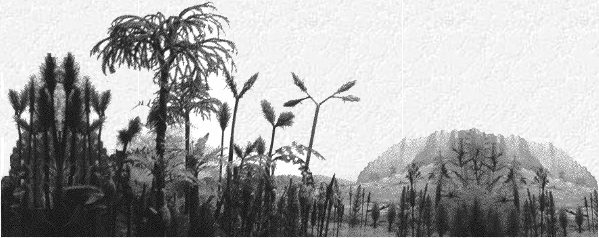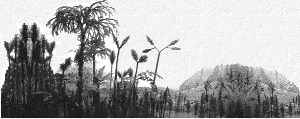Hans Kerp

 |
Geschäftsstelle der Senckenbergischen Naturforschenden
Gesellschaft Senckenberganlage 25 D-60325 Frankfurt am Main Fax: 00-49-69-74 62 38 |
Because the various researchers sometimes use different names for the same (groups of) plants, you might note some inconsistencies in the naming of the fossil plants. This applies also to the names of geological periods.
Contents:
Although the oldest life forms which were found in marine
sediments are as old as 3.5 billion years, continents
remained uninhabited for many hundred millions years. The
colonisation of the land by plants and animals did not occur
until some 415 million years ago, at the end of the Silurian.
Within the geologically relatively short time-span of only some
50 million years, following the first colonisation of the land
by small land plants, the flora diversified rapidly and
eventually gave rise to the oldest plants with a tree-like growth
habit.
As early as the Early Devonian up to two decimeters high, more
complex plants developed which partly also had naked axes, but
some had small spine-like protrusions, the so-called emergences.
Real roots were still lacking; water and nutrients were taken up
by so-called rhizoids. These are multicellular hair-like
appendages which developed where the axes laid down on the humid
substrate. On the basis of their overall morphology, the anatomy
of the vascular bundle and the shape and position of the
sporangia, several groups of plants can be distinguished in the
Early Devonian, including the completely extinct Rhyniophytes,
the Zosterphylls and the first representatives of the lycophytes
or clubmosses, a group which is still existent today.
In the Middle Devonian the next evolutionary steps became
apparent. These were the development of true roots, which is of
course also of importance for the formation of soils, and the
development of even more complex vascular systems which from
now on also provided stability. Middle Devonian plants could reach
a height of a few meters. At the same time further prerequisites
for a tree-like growth habit were attained like the formation of
secondary wood. In the lycophytes which have long and narrow, or small needle-shaped leaves
the evolution of the leaf was already completed, whereas in other
groups of plants a differentiation into larger axes and shorter
strongly branched lateral axis systems had just begun. These latter
lateral axis systems can be interpreted as the forerunners of
fern-like fronds.
Thus in the Middle Devonian all basic conditions for a tree-like
growth habit and the formation of larger-scaled forests were met.
As early as the Late Devonian the earliest tree-like plants
appeared and formed forest-like stands. These plants include
the earliest tree-like lycophytes which have been documented from
several areas such as Spitsbergen and Ireland. Another well-known
plant with a tree-like growth habit is Archaeopteris of
which numerous, up to 10 m long silicified stems have been found
in North America; their trunks basally may reach a diameter of
up to 1.5 m. This plant had frond-like axis systems with fan-shaped
leaflets and was heterosporous (having small micro- and much larger macrospores).
The wood is anatomically remarkably similar to that of the
primitive conifers. The formation of micro- and macrospores is
the first evolutionary step towards the development of seeds. Because
of this combination of characters Archaeopteris is
generally regarded as the ancestor of the first gymnosperms.
The first seed plants appeared towards the end of the Devonian.
They belong to the pteridosperms or seed ferns, a rather
heterogeneous, completely extinct group which was, however, very
successful in the late Palaeozoic. These plants had fern-like
fronds and did not reproduce with spores but with real seeds and
pollen grains. With the appearance of the gymnosperms which are,
because of their life cycle, not so strongly bound to humid environments
as spore plants, the hitherto uninhabited hinterland could be colonised
successfully. Nevertheless, many early forms still preferred
humid habitats.
Within a, in a geological perspective, relatively short time span
of 50 million years a large diversity of plant groups had
developed (Gensel & Andrews 1984). Most of the presently still
existing groups (lycophytes, sphenopsids, ferns and gymnosperms)
had appeareded by the end of the Devonian. The earliest trees and
forests are Late Devonian in age.
During the Devonian floral provinces started to differentiate.
This can be related to differences in geographical position and
climate. This trend continued until the Permian (Cleal 1991).
This contribution focuses on the so-called Euramerican floral
province which consisted of large parts of Europe and North
America which then were parts of the same continent.
